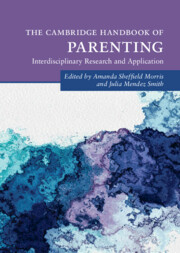Book contents
- The Cambridge Handbook of Parenting
- Cambridge Handbooks in Psychology
- The Cambridge Handbook of Parenting
- Copyright page
- Dedication
- Contents
- Contributors
- Figures
- Tables
- Introduction
- Part I Foundations of Parenting
- Part II Parenting across Development: Social, Emotional, and Cognitive Influences
- 8 Bolstering the Bond: Policies and Programs That Support Prenatal Bonding and the Transition to Parenting
- 9 Parenting during Infancy and Early Childhood
- 10 Parenting That Promotes Positive Social, Emotional and Behavioral Development in Middle Childhood
- 11 Parenting Adolescents
- 12 Parenting during Emerging Adulthood
- Part III Parental Factors That Impact Parenting
- Part IV Child Factors that Impact Parenting
- Part V Parent Education, Intervention and Policy
- Index
- References
11 - Parenting Adolescents
from Part II - Parenting across Development: Social, Emotional, and Cognitive Influences
Published online by Cambridge University Press: 01 December 2022
- The Cambridge Handbook of Parenting
- Cambridge Handbooks in Psychology
- The Cambridge Handbook of Parenting
- Copyright page
- Dedication
- Contents
- Contributors
- Figures
- Tables
- Introduction
- Part I Foundations of Parenting
- Part II Parenting across Development: Social, Emotional, and Cognitive Influences
- 8 Bolstering the Bond: Policies and Programs That Support Prenatal Bonding and the Transition to Parenting
- 9 Parenting during Infancy and Early Childhood
- 10 Parenting That Promotes Positive Social, Emotional and Behavioral Development in Middle Childhood
- 11 Parenting Adolescents
- 12 Parenting during Emerging Adulthood
- Part III Parental Factors That Impact Parenting
- Part IV Child Factors that Impact Parenting
- Part V Parent Education, Intervention and Policy
- Index
- References
Summary
The parent-child relationship continues to be essential to optimal adolescent development despite a restructuring of the relationship in response to developmental needs. In this chapter we provide an overview of parenting research during adolescence, including global aspects of parenting (e.g., parenting styles, warmth, control) and nuances of parenting that are particularly salient during the teen years (e.g., parental monitoring of media and peers, parental socialization of race, parent-child sex communication). We then highlight the ways in which parenting adolescents varies as a function of demographic factors such as gender and race. Finally, we explore policy applications of the research on parenting adolescents and suggest a number of avenues for future research. The most consistent finding in our review of research, cutting across studies of parental control, monitoring, media monitoring, peer management, parent-child sex communication, and policy research – was the importance of the parent-adolescent relationship in enhancing the effects of positive parenting and buffering the effects of negative parenting.
- Type
- Chapter
- Information
- The Cambridge Handbook of Parenting , pp. 236 - 258Publisher: Cambridge University PressPrint publication year: 2022



